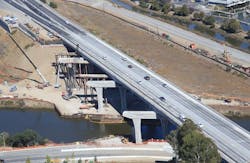When you join hands with someone, you never know how it is going to feel.
The Petaluma River Bridge Replacement Project was originally supposed to be separate from the adjacent Lakeville Highway (Highway 101/116) project. But when additional funds became available, it was decided to marry the two into one joint venture. When the merger took place, Ghilotti Bros. and C.C. Myers took more time and effort to reconcile the designs, especially when it came to roadway elevations at the structures and alignment changes. It led to a safer project both during and after construction with the elimination of an S curve between the southbound 101/116 ramp and the Petaluma River Bridge.
Other changes were made to address the approximately 1,000 ft where the Lakeville and Petaluma projects overlap. The joint venture and Caltrans aligned the staging for northbound and southbound traffic to be moved concurrently between the projects to minimize rework and public inconvenience. The move also simplified the detours, and resolved at least two conflicts. The northbound and southbound detour overlapped and prevented a portion of the bridge from being built until the northbound portion was taken out of service. In addition, the detour eliminated the need to temporarily have the roadway raised 6 ft to meet the new Petaluma River Bridge.
The new span will replace an 866-ft-long twin reinforced concrete box girder that was built in 1955. Petaluma, Part 2, will be 907 ft long with three lanes of traffic in each direction and standard shoulders, and will be one of the longest precast, post-tensioned splice concrete girder bridges in the western U.S. with main spans reaching 212 ft. The project also will be part of a corridor-wide improvement effort to eventually add high-occupancy vehicle (HOV) lanes throughout northern Marin and southern Sonoma counties.
The new bridge calls for the erection of 99 girders up to 130 ft in length. Each pier is unique, but in general the pier caps are supported on three columns. The project plans outlined the substructure bridge piles, footings, columns and pier caps were to be built in three stages. During construction it was determined that all three stages of substructure work could be constructed concurrently, including the three columns at each pier and corresponding pier caps below the exiting bridge soffit.
“To build a structure of this size in the same footprint as the existing two structures, while maintaining traffic on a major highway, spanning a river and a local road which is one of the primary routes into the city requires an enormous amount of planning and precise execution on everyone’s part,” Jeff Kress, senior bridge engineer with Caltrans, told Roads & Bridges.
Environmental restrictions were intense. There are seven permits and nine listed species. The bridge is surrounded at the north by an active salt-marsh, harvest mouse habitat that required the construction of catwalks.
Work was done at low tide with temperature monitoring to show that no alteration was made to the river. R&B
Project:
Petaluma River Bridge Replacement
LOCATION: City of Petaluma, Calif.
Owner:
California Department of Transportation
Designer: AECOM
Contractor:
Ghilotti Bros./C.C. Myers joint venture
Cost: $65.1 million
length: 907 ft
Completion Date: March 2016



